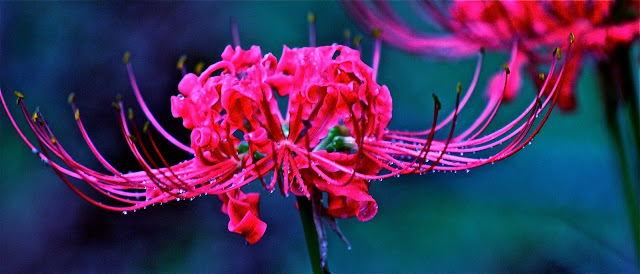 |
| Red Spider Lily |
Each September something almost magical happens across the South when red spider lilies, with their long, tropical-looking stamens, pop up and surprise everyone who had forgotten about them.
This amaryllis relative has had other common names over the years, including hurricane lily and schoolhouse lily -- so named because they bloom in hurricane season and, believe it or not, we used to start school in September. Those were the good old days.
It is also commonly called Naked Lady because it has a long, slim stem with no leaves.
Known botanically as Lycoris radiata, you might have thought it was native to the South because of the way it naturalizes with ease and brings color and beauty to the overheated landscape. But this fascinating, easy-to-grow bulb actually originates in Japan.
This year I saw more bulbs for sale than normal, making me think this old-time favorite is making a comeback. If you feel the need to run out and buy some red spider lilies now, you may be disappointed. These bulbs are at garden centers mostly in late winter and early spring.
Plant red spider lily bulbs in the spring in fertile, organic-rich, well-drained beds in full or partial sun. Place the bulbs 3 to 4 inches deep, spacing 6 to 8 inches apart. They can be planted in straight lines for a formal look, but usually look better in bold, informal drifts. Water the blooming spider lily well to extend its floral show as long as possible.
Once the flower is finished, the foliage arises and will make food for the bulb from fall or winter through late spring. The temptation is to mow those that have naturalized or cut them back for a tidy look, but this will harm the next season's bloom.
If you want to move this plant, divide in the spring as the foliage starts to turn yellow. This is the best way to get a really good stand. Even better is to get your own bulbs this winter.
Because the red spider lily doesn't bloom long, it makes a great addition to beds with a groundcover like ivy: the flowers will emerge above the groundcover but will not be missed when they retreat back to the ground. The long stamens give a tropical appearance that allows them to be used in and around bananas and elephant ears. Use them under rice paper plants, or try planting drifts among blue-green hostas.
In addition to the red spider lily, look for the white Alba, the yellow-gold Lycoris aurea (zones 8 to 10) and Lycoris squamigera, the real Naked Lady. This plant features pink blooms during the summer and is cold-hardy.

Tidak ada komentar:
Posting Komentar